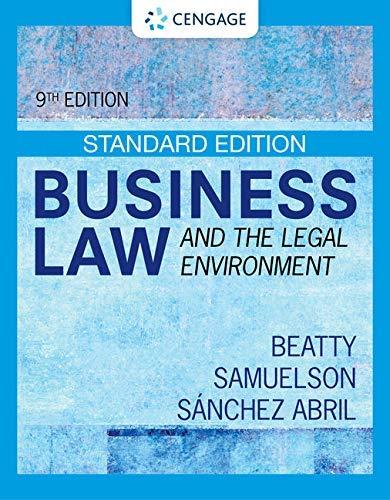Question
2024 LW353andLW453AssignmentontheBBNJ Treaty Areas beyond national jurisdiction (ABNJ), nearly of the ocean, belong to all but no one in particular: It is a global common.
2024 LW353andLW453AssignmentontheBBNJ Treaty
Areas beyond national jurisdiction (ABNJ), nearly of the ocean, belong to all but no one in particular: It is a global common. In 2018, after more than a decade of studies and two years of preparatory committee meetings, the United Nations Member States began negotiating theAgreement under the United Nations Convention on the Law of the Sea on the Conservation and Sustainable Use of Marine Biological Diversity of Areas beyond National Jurisdiction(BBNJ Treaty).
The Treaty, which includes binding and voluntary measures, aims to better implement the United Nations Convention on Law of the Sea, especially to protect and conserve the vast geographical area through better cooperation and coordination of various stakeholders. The Preamble as well as the operative text of the Treaty emphasize addressingbiological diversity loss and degradation of ecosystems of the ocean, in particular, due to climate change impacts on marine ecosystems, such as warming and ocean deoxygenation, as well as ocean acidification, pollution, including plastic pollution, and unsustainable use.It also has the goal to advance scientific research, globally. Further, the Treaty will ensure compatibility with existing roles and responsibilities of the various stakeholders.
Finally, one of the important aspects of the Treaty, particularly for developing countries, is to address existing inequalities in sharing the benefits (including access) accrued from the organisms of ABNJ and the associated digital sequence information. Such benefits could include a wide range of resources, including collection activity information, samples, information about publication, patents and commercialization. Also, the Treaty includes certain monetary benefit sharing requirements associated with commercialization from utilizing marine genetic resources of ABNJ and the associated digital sequence information.
On 19 June 2023, nearly 200 countries adopted the BBNJ Treaty by consensus. The Treaty consists of the Preamble, 12Parts, 76 Articles, and 2Annexes. The 53 pages of text represent over two decades of international collaboration among a wide range of stakeholders, not just countries: scientists, Indigenous Peoples and local communities, civil society, academic, research institutions, and the private sector.[1]The Agreement opened for signature in New York on 20 September 2023 and shall remain open for signature until 20 September 2025 and in accordance with article 68(1) it "(...) shall enter into force 120 days after the date of deposit of the sixtieth instrument of ratification, approval, acceptance or accession".
QUESTIONS
- What are the characteristics of biological diversity loss and degradation of ecosystems of the ocean that require it be dealt with in the form of a binding internationalagreement? (As opposed to the alternative where each country addresses its own problems of loss of ocean biodiversity, and/or the international community continues to engage in voluntary non-binding responses to loss of biodiversity in the ocean.)
- Before agreement on the BBNJ treaty, the legal and institutional frameworks for addressing the loss of marine biological diversity loss were fragmented, incomplete, and inadequate (well, they still are as the BBNJ Treaty has not come into force yet). This fragmentation is in large part due to two different governing principles applicable to the areas beyond national jurisdiction, namely the freedom of the seas regarding the high seas and the common heritage of humankind (CHH) in relation to the Area and its mineral resources. Please explain in a concise manner how these two principles have been reconciled in the BBNJ Treaty.
- What strategies does the BBNJ Treaty employ to broaden the personal scope of its obligations? Identify those strategies, refer to corresponding relevant Articles where applicable and provide a rationale for this broadening of scope.
- In a chronological table, identify four (4) provisions of the BBNJ Treaty that incorporate public interest norms (column 1) establishing collective obligations that protect common values to all the States Parties to the Treaty (column 2), not being subjected to any reciprocity. Briefly describe in one paragraph how each collective obligation you identified can be best implemented by Small Island Developing States (SIDS).
Your table should look something like this:
| BBNJ provision | Collective obligation to protect common values | Implementation option for SIDS |
| 1. | ||
| 2. | ||
| 3. | ||
| 4. |
FURTHERNOTESONTHISASSIGNMENT
Questions 1-3should be answered within a total word limit of 1200 words.Question 4is answered via a table that includes one row for each of the four identified provisions. Thistable isnotincluded inthewordlimit.
It maybe possible to pass this assignment by reading only the BBNJ Treaty text and combining that with other core course materials. Students who wish to receive better than a passing grade, however, must do their own independent research on thistopic.
There is available online a wealth of recent, high-quality documentation produced by UnitedNations agencies, national governments, academics, and non-governmental organisationsrelated specifically to the historic development, legal implications and expected results of the international legally binding instrument on the Conservation and Sustainable Use of Marine Biological Diversity of Areas beyond National Jurisdiction.
Footnotes presented in conformity with the USP Law Discipline Style Guide are expectedandnecessarytoshowthe researchyouhavedone.
[1] Harvard University: BBNJ Treaty, undated, at: https://bbnj-mgr.fas.harvard.edu/bbnj-treaty (accessed 29 February 2024).
Step by Step Solution
There are 3 Steps involved in it
Step: 1

Get Instant Access to Expert-Tailored Solutions
See step-by-step solutions with expert insights and AI powered tools for academic success
Step: 2

Step: 3

Ace Your Homework with AI
Get the answers you need in no time with our AI-driven, step-by-step assistance
Get Started


